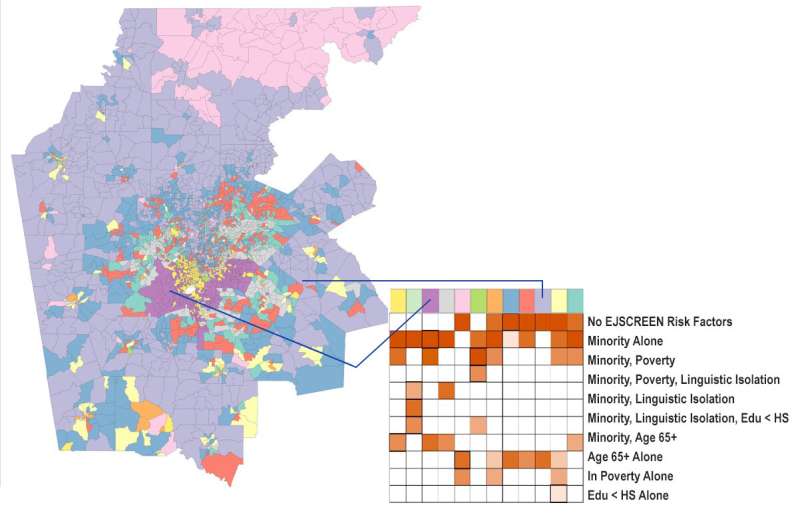Scientists develop environmental justice lens to identify neighborhoods vulnerable to climate change

A new capability to identify urban neighborhoods, down to the block and building level, that are most vulnerable to climate change could help ensure that mitigation and resilience programs reach the people who need them the most.
This method developed by the Department of Energy's Oak Ridge National Laboratory builds from environmental justice research—a key aspect of the federal government's strategy to manage the adverse effects of climate change. But until now, scientists had limited tools to assess and ultimately predict socio-economic risks in environmental events, particularly when multiple forms of vulnerability interact with each other.
"Climate modelers are very good at telling us exactly when and where bad things are going to happen in the physical world. But we also have to think about where the people are," said ORNL's Christa Brelsford. "Most of the world's population live in cities. In order to analyze climate risk, we have to think about impacts and vulnerability—and there's a lot of vulnerability in an urban environment."
ORNL project lead Nagendra Singh said climate modeling has mostly focused on "where things like a one-degree temperature increase will happen, or where there's going to be more heat waves in our climate models. But we have not stressed the fine details of those impacts—how climate events will disproportionately impact different communities. Applying this geodemographic data to the models is a good approach to generating the information needed by decisionmakers."
The ORNL scientists used microdata from the U.S. census to create a synthetic population, approximating the individual makeup of urban communities to assess the vulnerability and adaptive capacity of neighborhoods to climate events. The team gleaned demographic information such as income level, age, gender, ethnicity and housing from the census databases. They generated building characteristics data to determine whether a structure was an office, store, apartment building or other type of structure by applying machine learning techniques to satellite imagery. The combined data generated a high-resolution analysis of different impacts across socio-economic groups down to the street level.
ORNL scientists developed and tested the platform using data from the Atlanta metropolitan area to characterize neighborhoods and then evaluated the potential impacts from urban heat islands across different demographically defined groups.
The methodology builds on ORNL's long-standing expertise in measuring populations and environmental change, including the lab's Climate Change Science Institute and human dynamics modeling tools developed as part of its national security science research.
"Infrastructure is absolutely important for cities. People are absolutely important for cities. So is the environment and the climate and all of the natural physical characteristics," Brelsford said. "We can't understand cities as a whole without thinking about how all of these different sectors interact with each other."
When the science brings together climate factors, people, buildings and infrastructure, "we get a theoretically sound and rigorous way of understanding all three of the major features that make up cities," Brelsford said. "You have to do it all, as cities don't make sense without the interaction of people, goods, the environment and ideas. Cities are concentrators of multi sectoral interactions."
One of the roles at the DOE national labs is "making sure that the most vulnerable among us are equally and fairly and accurately represented in science, and we don't get to that when we only look at urban aggregates. We have to look at city-scale differences in order to do that well," Brelsford added.
"Taking a serious empirical look at city heterogeneity is a critical step in understanding how all of the major risks we face over the next decades filter down to actual people," she said.
Provided by Oak Ridge National Laboratory



















